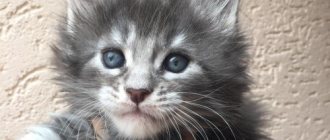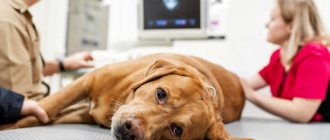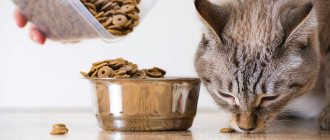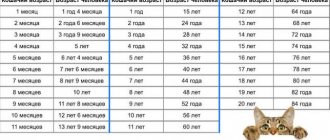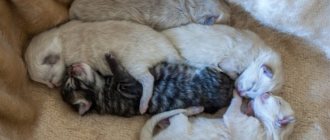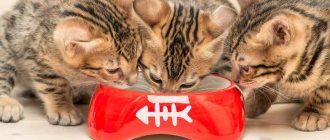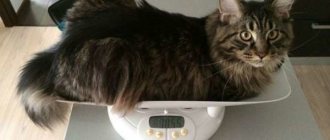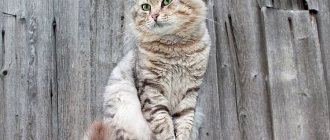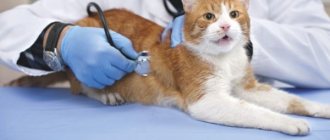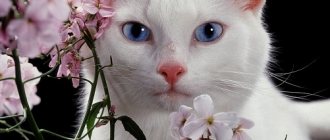When do kittens' teeth change?
Like all newborn mammals, kittens are born without teeth (in some cases, there may be dented incisors). But already in the first weeks of life, provided that the cat has normal development and a sufficient amount of milk, they acquire 26 milk teeth . Therefore, the question of whether cats have milk teeth is simply irrelevant.
Little kitty
At the age of 3-4 months, kittens' milk teeth are replaced with permanent ones, and no matter what condition they are in, they will serve him all his life. The timing of the beginning and end of tooth change is influenced by factors such as:
- cat breed;
- balanced bait;
- physical development, weight gain (age-appropriate).
Usually, the period during which baby teeth change passes unnoticed by the owners. However, if desired, the owner may notice signs such as:
- the appearance of a not very pleasant smell from the pet’s mouth;
- change in the kitten’s behavior (depression or irritability);
- lack of appetite in the baby.
Such symptoms arise as a result of the fact that, due to the pressure of the molars on the milk teeth, the gums become inflamed, and, as a result, the kitten experiences discomfort or even pain.
How the jaw is formed
Like humans, kittens are born toothless. However, bite formation occurs much faster than in children. After 2-4 weeks, the first teeth begin to emerge, and within a few months the process is completely completed.
Surprisingly, the sequence of teeth appearance corresponds to their eruption in children: the incisors appear first, followed by the canines and premolars. The last ones to come out are the molars. By three months, the kitten should have 26 teeth (14 on top and 12 on the bottom). But the process of jaw formation is not completed - almost immediately the change from milk teeth to permanent teeth begins, which occurs in the sequence of their appearance.
Normally, by the time of puberty, the cat’s oral cavity corresponds to that of an adult—that is, by 8-10 months the formation of the animal’s jaws ends. During this period, it is advisable to give the kitten food filled with phosphorus, calcium and other minerals that facilitate the process of eruption of molars and ensure their health.
How many teeth does an adult cat have?
In the oral cavity of an adult pet there is the following set of teeth:
- upper jaw: 6 incisors, 2 canines, 6 premolars, 2 molars;
- lower jaw: 6 incisors, 2 canines, 4 premolars, 2 molars.
Lower and upper jaws
Total 30 teeth .
As you can see, the number of teeth in a cat is almost the same as in a person. But unlike homo sapiens, a cat's teeth are primarily designed to capture and hold prey. In addition, the cat's dental apparatus has a carnascial (or carnassial) pair, which is formed by the upper premolar and lower molar. These pairs allow food to be chopped into small pieces (like scissors) and are important in a cat's diet because these carnivores are largely incapable of chewing.
Teeth as a sign of animal health
Of course, they are very important for any animal and, of course, people. Over time, incisors, molars or fangs will deteriorate - this cannot be avoided. And if a person can turn to a dentist for help, then cats have no one to rely on. The owner’s main task is to ensure that the teeth remain healthy for as long as possible. If they begin to deteriorate ahead of time, this will inevitably negatively affect the functioning of the pet’s body.
The reasons why they may fall out can be either physiological, that is, normal, or pathological.
They are typical only for young individuals. As mentioned above, initially the kitten grows baby teeth. They are temporary, and accordingly, over time they will be naturally replaced by permanent ones. In total, 26 dairy ones germinate, and 30 permanent ones.
In a healthy animal that does not suffer from any pathologies, the replacement of teeth with permanent ones occurs without any problems or pain. Often the owner does not even know about it. However, you need to examine your pet's mouth from time to time in order to detect developing pathology in time.
Sometimes the loss of baby teeth is delayed, but permanent teeth are already emerging. This leads to problems such as:
- malocclusion, as they simply interfere with each other and become distorted;
- redness of the gums, which indicates their inflammation. Bleeding may also occur;
- characteristic stench from the mouth.
In a healthy animal that does not suffer from any pathologies, the replacement of teeth with permanent ones occurs without any problems or pain.
During the period of changing fangs, the animal is in a depressed mood and often refuses food. The pet’s desire to chew on everything is just one of the external manifestations of this process. To prevent your kitten from chewing on your important things, buy him appropriate toys.
If you notice something is wrong with your little furry, be sure to take him to the vet. An incorrect bite will cause the animal a lot of discomfort in the future, so this should be avoided.
The main cause of early tooth loss in adults is classical dental diseases:
- caries;
- tartar;
- dysbacteriosis of the oral cavity;
- pulpitis;
- periodontitis.
An important role is also played by concomitant disorders that seem to have nothing to do with teeth. First of all, this is:
- immunodeficiency states;
- urolithiasis disease;
- diseases of the gastrointestinal tract;
- problems with liver function.
A lack of minerals and vitamins in the body can also provoke the premature loss of the pet’s main weapon. This is especially true if the cat does not receive enough calcium, phosphorus and all groups of vitamins.
Determining age by teeth
You can tell the approximate age of a cat by looking at its teeth, as they go through different stages of development throughout their lives.
To examine your pet's teeth, choose a time when he is relaxed or resting. Try to identify the types of teeth to get an idea of your cat's age.
The age of a kitten can be determined by the following characteristics:
- The first teeth that a baby grows are incisors (about 2-4 weeks old) and canines (about 3-4 weeks), then premolars appear (about 4-6 weeks).
- A cat younger than 4 months will not yet have molars . At this age, the cat's teeth should be white and show no signs of wear.
- milk teeth are smaller and sharper.
Whether cats lose their baby teeth is not a question. Like all mammals, cats change their teeth to permanent ones.
As a cat matures, its teeth show signs of aging. You can tell how old a cat is by the degree of wear and yellowing:
Baby teeth
- A slight yellowing on the cat's teeth indicates that she is about 2 years old.
- Between 3 and 5 years of age, your cat will experience more yellowing of her teeth. The wear of the central incisors becomes clearly visible.
- Between the ages of 5 and 10 years, your pet will experience significant yellowing of its teeth. They are dull and have obvious signs of abrasion: the chewing surface of the incisors begins to collapse. By the age of 7-8 years, the incisors on both jaws become worn out.
- At the age of 10 years and older, a cat will show obvious signs of yellowing on all of its teeth. They are noticeably worn. At this age, some teeth may be missing. The older the cat, the more likely she is to have tartar and gum recession.
It must be stated that this is far from an accurate tool for determining the age of a cat, because the condition of the teeth is influenced not only by the life stage of the animal, but also by factors such as care, feeding and health of the pet.
The True History of Brushing Cat Teeth
The author of these lines, while writing the article, also decided to look into the mouth of his cat, and this is what came out of it.
To begin with, the peacefully sleeping cat was awakened by demands to show his teeth.
I don't know about other pets, but ours will never do what we want. And now, apparently out of spite, he tightly closed his jaws no worse than a real bulldog and flatly refused to satisfy our curiosity. I had to resort to a “master key” in the form of a piece of sausage. While Barsik quickly chewed it, suffering from obsessive attention to his person, we tried to count his teeth. The sausage ran out before it was possible to do this.
So, the age of the cat could not be determined. But, looking into his mouth, I managed to notice that his fangs were not at all as white as I would like, and were covered with a yellow coating. The smell also left much to be desired. Considering that, in principle, the cat leads a healthy lifestyle and has no bad habits, this was strange. However, no one had ever brushed his teeth, but apparently they should have.
Often, in order to brush a cat’s teeth, you have to “persuad” him for a long time to open his mouth.
My daughter was perplexed as to why she needed to brush her cat’s teeth. I explained that yellow plaque can lead to tartar, which can lead to caries and even tooth loss. In addition, brushing your cat's teeth would eliminate the unpleasant odor from the cat's mouth.
One method of cleaning cat teeth found on the Internet was to rub the animal's teeth with red wine and soda.
Such a proposal was met with indignation by both the cat and the husband, from whom the thought of transferring a valuable product caused protest. I clarified that the wine needed was cheap, like vinegar. The husband unexpectedly objected that it was forbidden to rinse the cat’s mouth with anything (he managed to realize that it was unlikely that a whole bottle would be used for one cat, and therefore it could then be used for its intended purpose). This means that the wine must be worthy.
Barsik resolutely made it clear that he would not allow such dubious experiments to be carried out on himself. However, the husband no longer insisted on his participation in drinking good wine.
Another option for cleaning teeth was dry hard treats, the consumption of which gives the pet pleasure and removes plaque.
Alas, this method did not work for the cat either. No matter how we tempted him with chopsticks, no matter how we rolled our eyes, inhaling their wonderful aroma, no matter how we smacked our lips in delight, the cat did not buy it. He studied the so-called delicacy carefully, and then stared at us with contempt.
On the shelves of pet stores you can find special treats that (according to manufacturers) will not only please your pet, but will also help his teeth stay healthy
So, the relatively peaceful method of brushing the cat’s teeth did not work, and we had to take action.
It was decided to brush your teeth traditionally with a brush and toothpaste. They didn’t even offer our pasta to the cat, but bought a special one with the aroma of fish. Experts advise carrying out the procedure at the quietest time, when the pet has eaten and is not going to sleep. Here we encountered the first problem. The fact is that our cat either eats or sleeps. In between, he sits by the refrigerator and loudly hints that the couple should eat. Suggesting that he brush his teeth at this moment seemed extremely unreasonable.
The second problem was the lack of people willing to get into the cat’s mouth and generally participate in this process in any way, other than giving me stupid advice. Everyone still remembered well how they once stuffed Barsik into a carrier, taking him to the dacha, how he resisted and what damage he caused to those around him. I hoped that my husband would at least hold it, and I read the instructions to him. According to it, the cat needs to be placed between the legs, with the tail towards you, because the cat, apparently not enjoying the process, will begin to back away. My husband vividly imagined this, shuddered and asked with offense why some stupid cat was more valuable to me than the life and health of my husband.
This means that the cat will have to be swaddled, as some advise. I resolutely went in search of the cat with a blanket and a support group staying at some distance. The cat was found staring drowsily into the bowl and indulging in thoughts: whether to eat more, or to sleep already. When he saw us, he became alert and covered his ears. Then he quickly, forgetting about dignity, slipped under the sofa.
I sat down next to him and gave a heartfelt speech about the dangers of tartar and the need to brush your teeth. I scared the cat by going to the dentist and promised unlimited visits to the refrigerator if he agreed. The cat remained stubbornly silent and did not come out.
They managed to catch the cat only after a couple of hours. And the operation began:
- They threw a blanket over Barsik and wrapped him tightly in a ball. The cat fought like a lion and screamed loudly.
- They freed the cat's head. The resisting lump was unwound on one side - a large red butt appeared before our eyes, it was shoved back, and a grinning muzzle was revealed on the other side.
- Experts advised taking a brush like one for small children, that is, made of soft silicone that fits on your finger. It’s a pity that they didn’t warn that the cats’ teeth would pierce this structure instantly, as I was convinced of by frivolously sticking my finger into the screaming mouth. Here my screams were added to the cat’s screams.
- I quickly grabbed the first toothbrush I came across, as it later turned out very inopportunely, it was my husband’s. There was no time to smear it with paste; the patient dangerously turned out of the trap. The cat furiously attacked the brush, trying to bite it. Apparently, this is the meaning of brushing your teeth, it flashed through my head.
- Having taken revenge on the instrument for all the insults, Barsik finally freed his paws with outstretched claws, after which the desire to hold it instantly disappeared. Having hit everyone with its paws a couple of times, the cat proudly but hastily left the battlefield. He crawled under the closet and was loudly indignant at what had happened.
Repeating the procedure is not in the plans of either me, the support group, or the cat. However, the thought of using the services of a specialist in a veterinary clinic scares us no less...
Dental care
Brushing your pet's teeth should be an important part of the grooming routine. There are toothbrushes and toothpastes designed specifically for pets. They remove plaque and bacteria that develop in your pet's mouth and have adverse effects on your pet's oral health and overall well-being.
Of course, brushing the teeth of an adult cat that is not used to this process can be a difficult procedure. However, after a few brushings, both you and your pet will get used to it. It is advisable to brush your cat's teeth daily (or at least weekly) to promote healthy teeth and gums.
Important! Human toothpaste should not be used as the fluoride in it is toxic to cats.
Teeth cleaning
Prevention of dental diseases
Simple prevention of dental pathologies and timely visits to specialists is the key to healthy teeth for your pet.
The role of nutrition
Pet nutrition plays an important role in maintaining dental health. A balanced diet and vitamin intake are very important, especially during the growth period of the animal. Bone tissue must be fully formed to provide the animal with healthy and strong teeth for its entire life.
If the animal eats industrial feed, then additional vitamin intake is not required, provided that the feed is of the highest quality. Such products are expensive and are sold only in veterinary stores, but not in supermarkets near your home. But such food will provide the animal with all the necessary substances for health.
Only premium and super premium food will provide your pet with all the necessary substances for proper development
Look for the mark on the packaging - super premium or premium class.
If the animal is on a natural diet, it needs additional vitamins. They will be prescribed by a veterinarian.
Vitamin preparations are available in different brands; a veterinarian will prescribe the appropriate product for your pet.
Water mode
Water perfectly cleanses the oral cavity. This happens due to the irrigation of the mouth and the washing away of pathogenic bacteria. The presence of a large amount of contaminants and “bacterial overgrowth” will indicate a bad smell from the pet’s mouth. It must be remembered: water must be constantly within its access zone. It needs to be changed at least twice a day. It is also necessary to wash the water bowl daily.
Cat Oral Hygiene
A very important aspect is oral hygiene. No matter how funny it may sound, a cat also needs a toothbrush. Of course, you can’t use human toothpaste to brush your cat’s teeth. There are special products for this procedure.
But the process itself differs little from what we are used to. Using a brush, sweep the entire surface from the gums to the edges of the teeth.
The process of brushing a cat's teeth is not much different from what we are used to.
Your pet's teeth need to be brushed a couple of times a week. A kitten should be accustomed to this procedure from childhood. An adult cat will not allow you to calmly carry out all the necessary actions if he does not take them for granted. If plaque or tartar is advanced, you can only brush your teeth under anesthesia. This is a very unpleasant activity for a cat.
I tried to brush my cat's teeth with a special brush, but it seemed uncomfortable to me. The cat is not sitting very calmly, even though I wrapped it in a towel. And I'm always afraid of hurting her. It works much better when you wrap a bandage around your finger and quickly go over all the teeth with your finger. And lately I’ve been using a children’s silicone finger tip to brush my teeth. It came with toothpaste, but a child can clean it just fine with a brush, but it was suitable for a cat. It’s also a very convenient thing, the bristles are soft and the paste spreads well.
Video: how to brush a cat's teeth
Other recommendations
In addition to all the above methods for preventing dental health, there is one more, very important point. This is a regular check-up with a doctor. The specialist will detect emerging health problems and will deal with them in a timely manner.
Regular consultations with a veterinarian will protect your cat from developing dental diseases.
Reasons for loss
Examining your pet's oral cavity will help you find out not only whether all the teeth are in place, but also in what condition they are. To do this, the pet is placed on a well-lit, stable table. A quick inspection only takes a minute or two. Most pets are comfortable with this procedure.
But before you open your cat's mouth, inspect its face for swelling. Often a broken upper fourth premolar will cause an abscess that can spread to the area under the eye. Fractures of the upper canines (or eye teeth) can also cause swelling of the upper part of the nose. Next, feel your neck below your ears. Abnormal swelling of this area may occur due to infection, cancer, or inflammation.
The main causes of tooth loss are:
- The natural aging process of a pet. Compared to humans, cats have better dental apparatus: a thicker protective layer of enamel and less destructive saliva. Cat food contains no sugar, and food particles are less likely to get stuck between teeth. And yet, as they age, they lose teeth. Cats usually adapt quickly to tooth loss and can cope with food even if some or all of their incisors are missing. Some cats can still eat dry food even if all their teeth have fallen out.
- Changing teeth in kittens. As a rule, the absence of a tooth does not cause any inconvenience to the baby.
- Oral diseases. Lack of regular cleaning can lead to loose teeth and periodontal disease. Due to the accumulation of bacterial byproducts on the gums, the bone that holds the teeth in their sockets is destroyed. The teeth begin to loosen. Not only does this make it inconvenient for your cat to eat, but she may end up with loose teeth. The incisors are usually affected before the back teeth.
In addition, a cat can lose teeth by grabbing something hard or in a fight with other animals (cats, dogs). Also, the cause of tooth loss can be injury (fall from a height, blow to the jaw).
Stomatitis
There is growing evidence that various organs of the body can be affected by bacteria and toxins that enter the body through the bloodstream from the mouth. Chronic inflammation in a pet's mouth can cause problems such as elevated liver enzymes, heart disease, kidney disease and diabetes.
Changing baby teeth to permanent ones
At the age of three months, kittens begin to lose their milk teeth, gradually being replaced by molars. This process is usually complete by six or seven months, but don't worry if it takes longer for your kitten. Such deviations are usually associated with the breed of cat or characteristics of individual development.
However, if a new tooth grows on a baby tooth and this causes discomfort to the pet, then you should definitely consult a specialist. If such growth does not bother the animal, then a visit to the veterinarian can be postponed, since baby teeth can calmly and painlessly fall out even after the main shift.
Teeth change schedule
A healthy adult cat should have thirty permanent teeth: twelve incisors, four canines, ten premolars and four molars. Each of them serves her for a specific purpose, for example, incisors are needed to tear food, fangs help to capture prey, and so on.
A cat's permanent dental formula is formed after six months. It includes: on top - three incisors, one canine, three premolars, one molar; below - three incisors, one canine, two premolars, one molar. When calculating, all coefficients are doubled, so the total is thirty permanent teeth.
This is what the jaw of an adult healthy cat should look like with timely and correct teeth replacement.
Table: schedule for the eruption of permanent teeth and their functions
| Teeth | Quantity (lower/upper jaw) | Period of eruption | Function |
| Incisors | 6/6 | 3.5–4.5 months | Grabbing |
| Fangs | 2/2 | 5 months | Tearing |
| Premolars | 6/4 | 4.5–6 months | Chopping |
| Molars | 2/2 | 4–5 months | Chopping |
Symptoms of tooth change
The process of changing teeth can begin and even end unnoticed by you, since the kitten usually does not experience pain. Most often, the change of teeth becomes obvious when a lost baby tooth is found.
Nevertheless, there are a number of symptoms that will help you navigate and notice in time the process of changing teeth:
- When a kitten's teeth change, an unpleasant odor may appear from the mouth, which is often associated with poor nutrition. There is no need to do anything about this, it will quickly disappear once the teeth renewal process is completed.
- Kittens may experience discomfort during the actual cutting of new teeth, so the animal's behavior will change slightly. For example, a slight increase in temperature is likely (the norm is a temperature of 38 ° C to 39 ° C, for small kittens a higher temperature of up to 39.5 ° C is typical). As a result, the kitten feels the cold more strongly and tries to spend more time next to the warm body of the owner: on the lap or in the arms. At night, pets can crawl under the covers, even if this was previously uncharacteristic for them.
- You need to carefully ensure that the kitten does not swallow a lost tooth while eating. If this happens, you should not immediately run to the veterinarian; usually the tooth comes out naturally. However, it can also get stuck in the intestines, causing pain. The kittens then become aggressive and their temperature rises. In this case, you need to contact a specialist.
- During the period of teeth change, the pet will more often try to taste everything or chew on it in order to get rid of loose teeth.
- From this moment on, cats begin to mark their territory.
- Redness of the gums may be observed, which is better to contact a specialist immediately so that chronic inflammation of the oral cavity does not begin.
- Sore gums can lead to refusal to eat. This is not a big deal, but if it lasts more than one to two days at most, you should change dry food to wet food, consulting your veterinarian first.
The author of these lines recently encountered the process of changing teeth in his kitten. Each animal exhibits specific symptoms, and when problems arise, it is easy for owners who know their animals to notice changes in behavior. So, my kitten usually did not hide under the blanket and did not play with some toys. When his teeth changed, he constantly chewed rubber sticks and tried to bite the scratching post. In this case, the baby teeth did not fall out immediately, but after the fangs were replaced.
Why does a cat need mustaches and eyebrows?
Why does a cat need whiskers? They are an important organ of touch. Many animals that feed on their mother's milk have similar adaptations.
The hardest and longest whiskers of a cat help the animal navigate in space. These hairs are located on the cheeks, on both sides of the nose, above the eyes, on the chin and tail.
Such whiskers perform an important function due to the fact that there are sensitive endings at the tip of each whisker. The function of the whiskers is to transmit information about the surrounding world to the pet’s brain. This is how the cat knows when an obstacle or prey appears in its path.
What are whiskers called on cats?
Cat's whiskers also have another name that is not known to everyone. Scientifically, they are called vibrissae. Cats touch different objects with them to determine their size. For example, before climbing into a hole, a cat checks with whiskers whether it is of sufficient size.
Do hairless cats have whiskers?
The pet may not have them at all. Due to the nature of the breed, hairless cats may have broken whiskers, curled or not have them at all.
Sometimes the absence of vibrissae occurs in furry representatives of the cat family. This is due not only to the breed, but also to a kind of mutation.
Whiskers on a cat's paws and nose
As already mentioned, the whiskers of cats are located not only on the face, but also on the paws and tail. How many whiskers a cat has along the body depends on the breed and the specific representative.
The longest hairs on the nose reach seven centimeters. The Book of Records has registered a Maine Coon cat in Finland with whiskers nineteen centimeters long. Another Russian cat had a slightly shorter whisker length - only 13.5 centimeters.
The whiskers on the paws and tail are not so long; they can be distinguished by their greater rigidity. The number of rows of a cat's whiskers determines how well they navigate the world around them.

